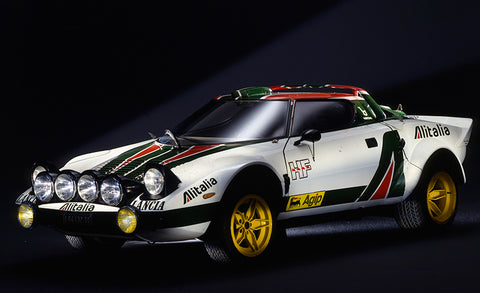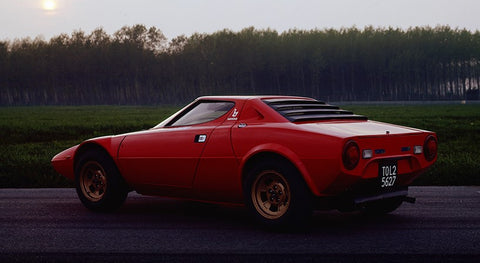Lancia Stratos HF - La bête à gagner.

Born to win or "La bête à gagner" - this is how the French literally dubbed the Lancia Stratos car when they realized that it would conquer everything and that there was no more hope for their Alpines.
And history has proven them right.Let's take a little excursion into history.
We are in 1970: at the Turin Motor Show. Strato's Zero prototype presented by Nuccio Bertone. This is a concept car with futuristic shapes, powered by a Lancia Fulvia 1600 hf engine.

Exactly one year later at the same fair, after several months of cooperation with the Lancia racing department, a new Stratos HF (High Fidelity) prototype is shown, the shape of which is very similar to the version that would later become the final and famous rally world.

The adopted engine is V6 Dino Ferrari. But it is not yet a fact that this will be the final engine. Against. The engine V6 was not suffucient - much more powerful engine is needed to defeat fierce competition. In the end, the choice falls on the six-cylinder V-twin engine Dino 246 Ferrari, whose power and reliability qualities have already been tested before.
We have to fast forward to May 1972 when Ferrari, after long negotiations, sold 10 Dino 246 engines (6 cylinders V 65° 12 valves, 2400 cc) to be fitted to Stratos prototypes intended for rallying. This is because, according to Cesare Fiorio, Lancia's sporting director, the Stratos HF could replace the now outdated Lancia Fulvia rallye.
November 1972 - Lancia Stratos took part in the Tour de Corse 1972 (as a prototype in Group 5) with his most representative rider, Sandro Munari.
In fact, the rules of the FIA required the construction of at least 500 identical copies in order to receive sports homologation in Group 4.
December 1972 - Enzo Ferrari decides to supply the required number of engines for the car to receive FIA sports homologation.
Thus was born a real racing beast (that French named "bête à gagner"), with a mid-rear engine in a transverse position.
The first win comes at the Firestone Rally in April 1973, signed by Sandro Munari and Mario Mannucci, who had already won many important awards with the Lancia Fulvia 1.6 HF.
October 1, 1974 - the Stratos received homologation for group 4. In the meantime, given that this is allowed by the sports regulations, a 24V engine of Lancia Stratos HF is being developed that provides power from about 280 to 320 (for a car weighing just under 1000 kg).
But there was a problem with directional stability, which did not allow the car to be fully exploited. Eventually, mechanics and drivers realized that the sheet-metal box-shaped rear wheel hub carriers, to which shock absorbers were also attached, deformed under load and returned to their original shape when the car was stationary. They were replaced with duralumin parts.

From this moment begins the legend of rally Lancia Stratos: three world championships won in a row in 1974/75/76.


With the official Lancia Stratos HF, Munari and Mannucci win the Sanremo Rally and the Rideau Lakes Rally in Canada. Driven by Sodano, Munari Lancia also wins the grueling RAC Rally in England. With Androuet-Bich's victory in the Tour de Corse, Lancia scored enough points to win the 1974 World Rally Championship, the first of a long series. In addition to everything, the Lancia Stratos won the 1977 FIA World Rally Cup.
The Lancia Racing Team used 26 official cars over the years: the first were equipped with 12-valve cylinder heads, later increased to 24. The cars were originally painted white and red by the sponsor Marlboro, which was changed to the white and green colors of Alitalia ( Alitalia Lancia Stratos) from the 1975 season G.

In 1978 the Lancia Stratos HF project was prematurely shelved in favor of the newborn Fiat 131 Abarth. But he could still have won a lot as demonstrated by the countless placements obtained by private riders and teams until 1982 when the homologation finally came to an end.
Let's take a look at the parameters of the Lancia Stratos HF GR.4 - 1972-1975
ENGINE:
6-cylinder V65° petrol, 2 double overhead camshafts, 12 or 24 valves, transverse centre/rear, 3 twin-choke Weber carburettors, 2418 cm³
POWER:
280 bhp at 8,000 rpm (12 valves)
320 bhp at 8,500 rpm (24 valves)
We at GPmodeling wanted to prepare transkits of these two engines, dedicated to the 24 valve version (the one used in the Alitalia versions from the San Remo Rally in October 1975 until all of 1977) and to the 12 valve version - second series - i.e. the one used for example in the Pirelli livery (relegated to the European championship only) and for all the races starting from 1 January 1978 as, due to the new Sporting Regulations, it was necessary to return to 12-valve engines.
From 1972 to October 1975, however, 12-valve engines were used for Lancia Stratos which were very similar to the road configuration with a different position of the alternator and battery compared to the latest version we proposed.

Project by Claudio de Bellis
You can buy transkits of both versions of the Lancia Stratos HF motor in our store here: 12v and 24v
Hasegawa Car model kit - Lancia Stratos 1977 Safari rally you can find here

